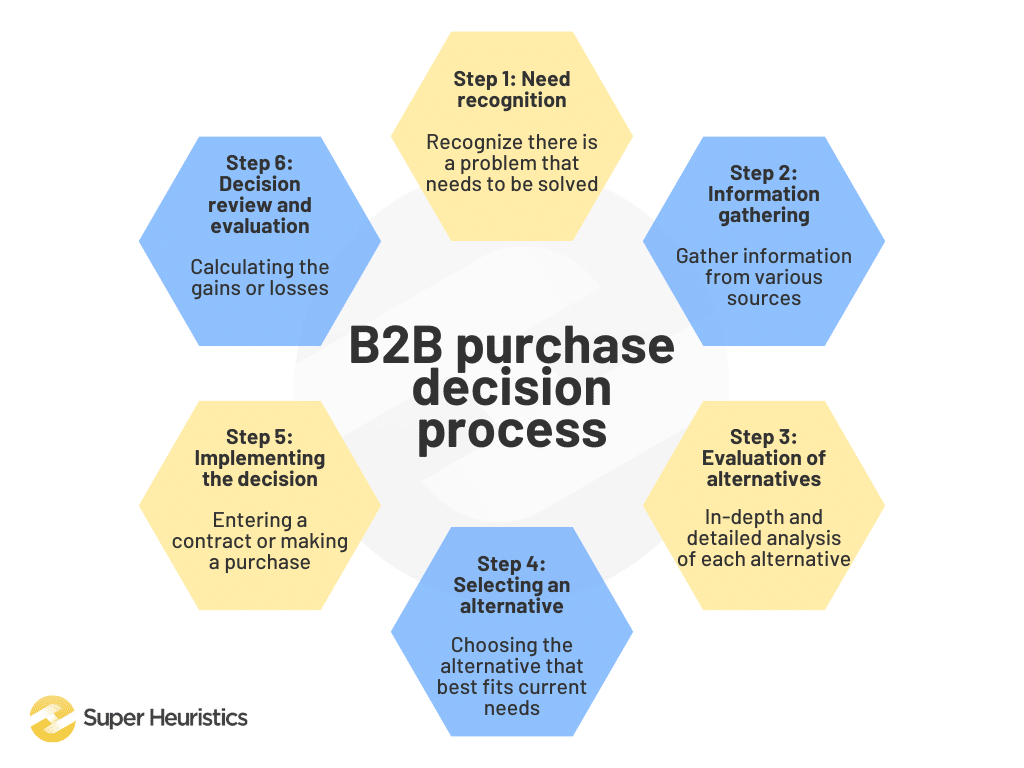The B2B purchase decision process is similar to the individual consumer’s buyer decision process we saw in the previous chapter. But since the B2B purchase will affect a much larger number of people and even organizations, there are some differences in the two processes as well. Let us first define the B2B purchase decision process.
The B2B buying process is the decision-making exercise buyers go through when purchasing from another company. (Shopify)
Before we move on to discussing the actual process, it is essential to understand why we need to study the B2B buyer decision process separately from the B2C buyer decision process. Let us look at the differences between the two.
Differences between the B2C and the B2B buyer decision processes
- In a B2C transaction, the term 'consumer' usually refers to a single end-user and sometimes to a group of consumers with a single interest (for example, a family buying a washing machine). However, in a B2B transaction, the 'consumer' is an organization consisting of various persons with varied interests (including but not limited to managers, shareholders, workers, etc.).
- Also, the typical B2C buyer decision process takes less time than the typical B2B buyer decision process. This also stems from the fact that there are many more end-users in a B2B transaction than in a B2C transaction.
- The retail consumer is normally concerned with maximizing utility from their purchases. On the other hand, an organization is concerned with maximizing its profitability from the goods and services it decides to purchase. Sellers must keep this in mind when designing and marketing products and services for these two separate groups.
Now that we understand why we need to study the B2B buyer decision process separately, let us look at the steps involved in the process.
Steps in the B2B buyer decision process

1. Need recognition
Reiterating what we have already seen in Chapter 8, this is the step where the consumer (in this case, an organization) realizes that they have a need that needs to be fulfilled. You can head back to the previous chapter to understand the difference between a want and a need.
At this stage, the marketer needs to make potential clients aware that they have a problem that only the marketer’s product can solve. For example, ERP (Enterprise Resource Planning) solution providers try to coax firms to purchase their products because only they can provide the organization with the organization-level, formal, online resource planning technology it needs to maximize its profitability.
2. Information gathering
Again, instead of restating what has already been covered in the previous chapter, we shall only say that information gathering is the step where the firm will try to gather as much information as possible about the competing products or services available in the market to fulfill its need.
If the organization was already aware or has been made aware of your brand, it is also possible that it may contact you directly to get more information. For example, the organization may contact an ERP solution provider to clarify whether the specific product it is researching can be customized to its needs or not.
3. Evaluation of alternatives
As is clear from the name, this step requires the organization to weigh its alternatives very, very closely. Every aspect of the available solutions must be reasoned with or argued against.
The difference between the evaluation of alternatives conducted by a single consumer and a firm is that a firm needs to perform this step in much more depth and detail than a single consumer. In fact, sometimes, information gathering and evaluation of alternatives may sometimes entail costs of their own.
For example, when a firm is evaluating the alternative ERP solutions in the market, it may want to check which of the solutions are customizable, which one is being used the most in its industry, which one its competitors are using, subscription or purchase models, whether the IT department can handle its regular maintenance, how complex the system is for end-users to use, etc.
4. Selecting an alternative
Unlike a single consumer, a firm cannot afford to buy something because it is purple in color or because its ad is flashy. A firm needs to maximize its profits.
This step entails summarizing what was found in the third step and then deciding which alternative will work best for the firm, given its current needs and the current environment in which it is functioning.
For example, a firm may check which ERP solutions had the least negatives and the most positives in the previous step to decide which one it ultimately buys or subscribes to, given the trends in the industry and the budget it has.
5. Implementing the decision
This is the step where the firm will finally start using the product or service it has decided to purchase. For example, the firm may first decide to deploy the ERP solution on a small scale before deploying it company-wide.
Here, the seller must ensure that the implementation process of the product or service is as smooth as possible. The process must be simple and straightforward, with the least cost to both parties.
6. Decision review and evaluation
In this step, it is very important for the seller to minimize the post-purchase dissonance of the consumer. As we studied in Chapter 8, cognitive dissonance is the discomfort caused by a post-purchase conflict.
This discomfort can be minimized by the seller through constant reassurance that help is always available, asking for feedback, asking how the experience can be improved, etc. It is important to remember that all B2B transactions create ongoing relationships, unlike one-time relationships created by many B2C transactions. Businesses rarely ever enter single-time transactions with other businesses, especially when their profitability is on the line.
Both the firms (buyer and seller) will evaluate the gains and losses due to the interaction. This will help them decide whether to continue to build the relationship or nip it in the bud. Unlike what is the common misconception, this is the most important stage for both parties because the seller is losing a customer, and the buyer will have to perform the costly buyer decision process all over again.
For example, the ERP solution provider can ask the firm for feedback, conduct seminars and workshops to resolve issues faced by the end-users, send engineers over to check in with the IT department of the firm to see how maintenance is going on, etc.
Conclusion and key takeaways
In this chapter, we have studied the B2B purchase decision process. To recall, here are some of the key takeaways:
The B2B buyer decision process consists of the following six steps:
- Need recognition
- Information gathering
- Evaluation of alternatives
- Selecting an alternative
- Implementing the decision
- Decision review and evaluation
In the next chapter, we will study the buyer decision process for new products.

